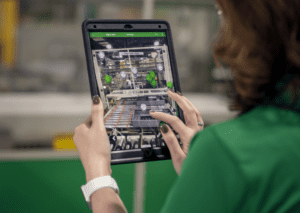Across key industries, the pace of supply chain process reinvention has accelerated. Upstream and downstream operations are linking at an unprecedented rate in response to rapid, unpredictable marketplace changes.
At Schneider Electric, we are laser-focused on intensifying supply chain innovation and modernization. Our digital transformation initiatives involve bolstering our supply chains in order to help our customers’ businesses become more predictable and agile.
By steadily modernizing our manufacturing plant and distribution infrastructure over the last several years, we have been able to weather pandemic-induced constraints through a high level of flexibility across our production lines.
Our employees understand that, in this hyper-competitive marketplace, relentless innovation is required to achieve ever-higher levels of customer satisfaction and efficiency.
In fact, many of our factory workers now feel a closer connection to our customers. They are able to witness, first hand, how new smart technologies work and how our customers are impacted in both their energy management and plant production efforts.
A case is point is our 60-year-old Lexington, Kentucky manufacturing plant. The plant builds and assembles industrial electrical system components such as load centers and safety switches.
Our plant management team was recently recognized by both the U.S Department of Commerce for the implementation of smart factory solutions, and cited by the World Economic Forum for achieving their “Advanced End-to-End Lighthouse” designation, exemplifying successful digital transformation.

Over the years, our management team and workers have adopted a Fourth Industrial Revolution (4IR) philosophy that combines technology upgrades with a culture of constant learning, while integrating the “voice” of our customers. On the technology side, a steady drumbeat of the integration of sensors, digital controls, and software platforms has helped us to optimize our performance at the production unit, plant, and supply chain levels.
Our digital linking of systems now allows us to make real-time decisions using data analytics, including the use of artificial intelligence (AI) techniques, to enable continuous improvement, and to render our operations more resilient. As we analyze the constant stream of data coming in from our connected operations and production systems our factory workers and managers find it much easier to learn and adapt to new customer demands.
Smart factory evolution and digital transformation success rely on people, not technology
In reviewing our experiences over the last 18 months, we have come to recognize that our smart factory success has resulted as much from the ability of our factory workers to increase their digital competence as from the digital technologies themselves.
Our human resources team has focused on what they call the three “E’s “: education, which makes up about 10% of the training work, exposure, which makes up 20%, and experience, which makes up 70% of the actual training.
Even though our people possess different levels of digital acumen, our job as a company is to get them to a level where they truly understand how these technologies make their job easier. We also have observed that when they recognize how their work influences the performance and success of others on the manufacturing plant floor, their level of job satisfaction and motivation goes up.
Maintenance technicians, for example, use portable tablets to access up-to-date equipment blueprints and maintenance history documentation with the click of a button. Pointing a tablet at a particular machine and scanning a bar code reveals in graphic detail what that machine looks like inside and indicates the operational state of the equipment.
Our employees learn how to diagnose issues much more quickly and to resolve problems faster. Long years of experience to get to know all of the machines is no longer required. This enables our maintenance people to spend more time learning new apps that aid in continually monitoring and optimizing equipment performance.
Since our people understand the value that the technology provides, we don’t encounter resistance to the process changes that are proposed. In fact, certain individuals spontaneously take on the role of digitization advocates, encouraging others to engage in the new process. Once the others fundamentally understand the benefits of these new tools, they quickly adapt themselves to the new systems.
Smart factory extends benefits across the supply chain
The digital-driven connectivity benefits we have been able to enjoy also extend to both upstream suppliers, who provide our Lexington manufacturing plant with the raw materials needed to enable production, both inside the plant and to downstream customers. Our plant personnel work closely with our upstream supply chain team to utilize the Schneider Electric supplier web portal. The connected systems provide our supply chain experts with visibility to our suppliers’ raw materials forecasts and relevant shipment data, in real time.
Inside the plant, if an equipment failure or shortage occurs, we receive an immediate alert in the system and are able to quickly respond or switch to alternate sources of supply. Our connected systems enable us to combine supply, demand, and inventory planning on an ongoing basis for faster and more accurate decision making.
Software dashboards connect the forecast and demand planning teams, to the manufacturing plant floor personnel, and to the upstream inventory support. From a downstream perspective, a control tower managed by the logistics team, provides alerts on a real time basis regarding the flow of those inventories. Team members determine whether customer deliveries are arriving on time or not, track key KPIs, and fulfill their tasks in a way that supports the company program goals of sustainability, trust, resilience, intelligence, speed and efficiency.
For more information
As new Industrial Internet of things (IIoT) technologies have emerged, I have witnessed that old issues can now be addressed in new, more affordable ways across the industrial landscape. Connectivity and integration have become a key focus point and plant modernization has directly opened the door to higher profitability. To learn more about how our Schneider Electric digitization architectures can benefit your business growth, visit our smart factory website.



